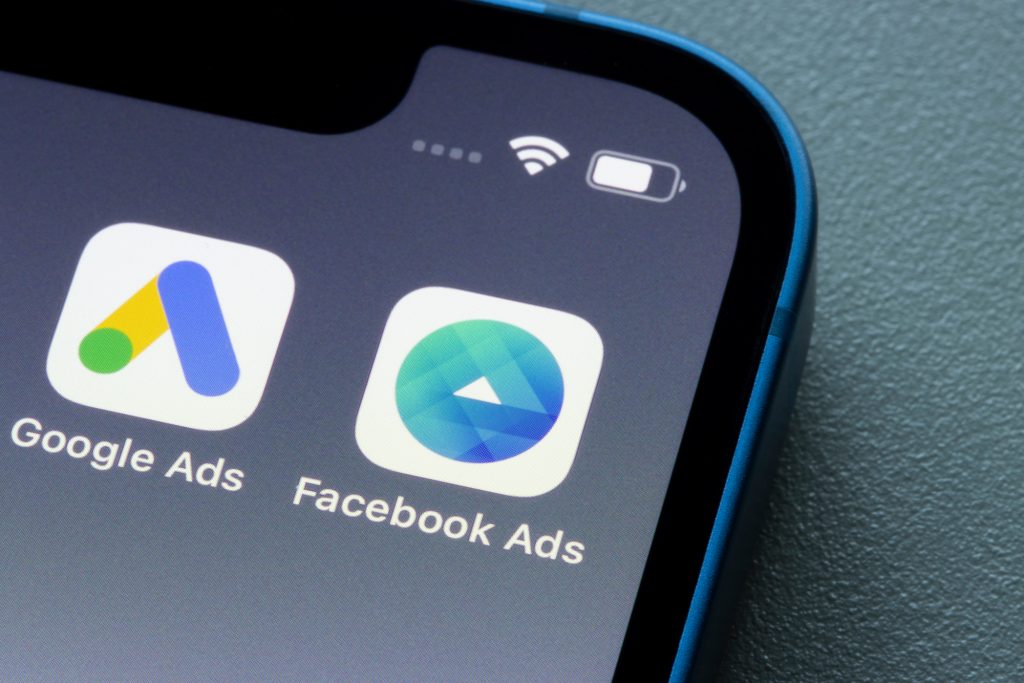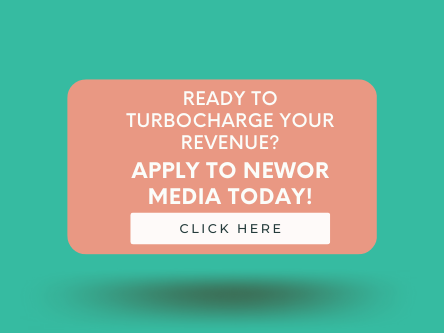
There are more than 218 billion app downloads every year and the average smartphone has more than 40 apps installed. App usage continues to grow and so does revenue from mobile apps. Apps are forecast to generate more than $469 billion in 2022 and are expected to grow to $613 billion by 2025. In-app advertising alone accounts for more than $200 billion.
Due to how many new devices and apps are always being released, it can be hard to keep up, so app developers need to stay focused on what works best for their niche. That’s why nearly every mobile app uses an ad exchange, a digital marketplace where publishers and advertisers can buy and sell ad inventory such as native ads or video ads.
A mobile ad network can provide revenue opportunities in a passive way. By incorporating advertising networks into your app marketing stack, you can deliver different ad formats and monetize your app.
How Do Mobile Ad Platforms Work?
Mobile ad platforms connect advertisers with app developers looking to monetize their mobile apps. App publishers can sign up for a mobile ad network at no cost, make advertising space available, and start getting paid.
Ad networks use supply-side platforms (SSPs) where app developers make their ad space available. An ad exchange acts as an intermediary between the SSP and the demand-side platforms (DSPs) where advertisers build ad campaigns and bid on ad space. An SSP allows app publishers and game developers to make their ads available to multiple ad exchanges and thousands of advertisers. A DSP lets publishers buy ads that meet their parameters across multiple apps and websites.
Once the ad space has been purchased, ads will be displayed somewhere on the screen while a user is on the app. Algorithms and automation make all of this happen in milliseconds, so when ad calls are placed by an app, the real-time bidding, buying, and serving happens in the blink of an eye.
Whether it’s an iOS app or Android operating system driving an app, advertisers will focus ad campaigns on a target audience as part of their mobile marketing mix. The marketing platform integrates the ad network for seamless delivery and provides the metrics for analytics for both app developers and advertisers.
In-app ads use different models for monetization, including:
- CPM stands for cost per mille (cost per thousand). Advertisers pay apps for every thousand views their ads get.
- CPC stands for cost per click and is also known as pay per click (PPC). Advertisers pay apps every time someone clicks on an ad.
- CPA is a cost-per-action model. Advertisers pay app developers when an ad click leads to a specific action by users. This might include making a purchase, registering at a site, or signing up for a newsletter.
- CPI is cost per install. When someone clicks on an ad and downloads an app, it triggers a payment to the app publisher.
- CPV stands for cost per view. Advertisers are charged each time a mobile video ad is viewed.
All of these methods are used frequently by advertisers. CPI is common with game developers, who use mobile marketing strategies to get people to download and play their games.
How to Choose the Best Mobile App Advertising Platform
When choosing the best mobile app advertising platform, there are several key factors you will want to evaluate. Obviously, you want a high-quality mobile ad platform with deep experience in programmatic ad sales, as more than 90% of all digital dollars are spent programmatically.
You also need to evaluate these features.
Network Type
Due to the different types of apps, ads, and audiences, you’ll want to make sure the advertising platform is a good fit for you.
For advertisers, that means matching the target audience to the right network. For example, if you’re trying to market to Baby Boomers, TikTok probably isn’t the right fit.
For app developers, you want a network that provides diverse and broad access to a variety of advertisers that will fit your niche.
Demographics
It’s key to make sure that within the platform, advertisers can narrow searches based on factors such as:
- Location
- Age
- Gender
- Likes & interests
- Job
- Relationship status
- Education
The better app publishers can help define the demographic makeup of their mobile web users, the more attractive it will be for advertisers looking to reach a target audience. When the user base matches up with advertiser targets, they are more likely to buy ads.
Not every platform will allow advertisers to focus on demographics. For example, LinkedIn will let you specify these demographics, but Google Ads will instead have you focus on keywords that the audience might use on its search engine.
App Category
There are six basic categories of mobile apps and most apps fit into one of these. They include:
- Educational apps
- Lifestyle apps
- Social media apps
- Productivity apps
- Entertainment apps
- Gaming apps
You will want to look for a mobile app advertising platform that has experience delivering ads in your category.
Certain categories may be more difficult to find the right partner, especially when it comes to apps that focus on content such as:
- Adult
- Alcohol
- Dating
- Gambling
- Sweepstakes
- Political
- Religious
- Suggestive
- Tobacco
- Violence
Pricing
App developers looking to monetize their apps need to compare pricing models, both in the type of available ad options as well as the monetization model. Each ad platform will work slightly differently. Obviously, publishers want those that provide the highest rates.
Functionality
Functionality is key to providing a solid user experience. You want a platform that works in near real-time to provide a seamless experience for users.
Integrating the software development kit (SDK) into the app allows third-party services, like an ad network, to connect.
Popular Mobile Advertising Platforms
The most popular advertising platforms include the following:
AdMob
AdMob is a Google company and is one of the largest ad networks worldwide. It allows app developers to show as from millions of Google advertisers. You can also choose AdMob Mediation to access more than 40 ad networks to broaden your advertiser base. To use AdMob, however, you’ll have to sign up first for Google Ads.
AdColony (Digital Turbine)
AdColony was recently acquired by Digital Turbine. It’s the largest independent mobile ad platform for digital advertising. They don’t do monetization for mobile websites or social media. They focus on mobile ad options for apps on mobile devices.
Tapjoy
Tapjoy approaches monetization slightly differently, focusing on ad offers, such as offering virtual currency inside gaming apps, offer walls, or providing app users with rewards for taking certain actions. Tapjoy also features real-time bidding to maximize yields.
Google Ads
Google Ads can help app developers get the word out about their apps. Whether it’s displaying your app on a search engine when people are looking for specific topics or types, or in-app advertising for your app, Google Ads is another option for marketing.
While Google Ads places ads on mobile and web, AdMob is used by publishers to monetize apps.
Facebook Ads
As one of the most visited websites, Facebook can be an effective place to market apps. More than 98% of users access Facebook via mobile devices, which makes it easy for someone to click on an ad and download an app.
For publishers, you can also tap into the Facebook Audience Network to monetize your app.
Instagram Ads
Instagram is also owned by Meta, the parent company of Facebook, and you can integrate ad campaigns across both Facebook and Instagram using Facebook’s targeting options.
While app developers do not have to implement the Facebook SDK to run Facebook or Instagram ads, doing so allows for more options.
TikTok
TikTok has a younger audience than other social media platforms and is the fastest-growing. As such, it’s a good alternative to market apps, especially those aimed at younger audiences. TikTok specializes in short-form video ads.
Newor Media
Newor Media connects website and app publishers with advertisers to monetize their apps and offers some of the highest yields for developers. Using industry-leading ad tech algorithms and hands-on attention from dedicated Ad Ops experts, Newor Media allows app developers to maximize ad dollars and advertisers to maximize conversions.
Types of Mobile Ad Formats
There are several different formats to choose from. For either Apple or Android operating systems. Here are some of the top-performing types of ads.
Mobile Rich Media Ads
Rich media ads include interactive elements intended to increase engagement. They often incorporate text, images, animation, video, audio, and ways for users to interact. They generally are more attention-getting than mobile banner ads and generate higher levels of engagement and conversions.
Mobile Banner Ads
Mobile banner ads or display ads are static ad units. These can be displayed at the top of the bottom of the screen or shown full screen. They can also be shown as interstitial ads between elements as users transition from one section of an app to another. These are generally the cost-effective ad units and the most popular ads for mobile apps.
Mobile ad banner sizes vary, but the most common sizes for smartphones include:
- 320 x 480
- 300 x 250
- 320 x 50
For tablets and larger mobile devices, the most popular ad sizes include:
- 728 x 90
- 768 x 1024
- 300 x 60
Mobile Native Ads
Mobile native ads are designed to mirror the look of an app’s content. Such ads are non-intrusive as they align with the design and style of the app where they appear. While they must be labeled properly, they are a more subtle way of advertising and generally deliver value for users beyond the advertising message.
Native ads come in all sorts of shapes and sizes, designed to fit organically into the content of the app itself.
Mobile Video Ads
Mobile video ads play full-screen on devices, helping capture and hold a user’s attention. Video ads can be used in different ways depending on the type of app. For example, they may run as pre-roll, mid-roll, or post-roll as other videos play. They can also be used as interstitial ads, placed during a natural break in a user’s journey in the app.
With today’s fast internet connection and the roll-out of 5G, mobile video ads are increasing in popularity and generally have better campaign performance metrics.
Common sizes include:
- 320 x 480
- 480 x 320
- 768 x 1024
- 1024 x 768
- 320 x 250
Playable Ads
Playable ads are among the most popular ads types for gaming apps. They provide a short preview for users to see how an app works and highlight game features designed to get clicks and downloads. Playable ads provide an interactive way to drive engagement. They typically run full screen. As users complete the ad content, they are then shown another ad (called an end card) encouraging them to download and complete an app install.
These types of ads run full-screen and can be user-initiated or as interstitials during natural breaks in gameplay.
Rewarded Ads
Rewards ads are also popular in mobile games. App users are presented with an option to view an ad in exchange for a reward. By initiating and opting into viewing, the ad server shows the ad, then algorithms award players virtual currency or special items to use during gameplay.
These ads run full screen upon user initiation.
What’s the Best Way to Advertise an App?
If you’re looking to promote your app, it can be a bit daunting. There are more than 3.5 million apps in the Google Play app store and 2.2 million in the Apple App Store in 2022. It’s a challenge just to make sure people see and find your app. Even in niche categories, there are often dozens of different app publishers so making your app stand out from the crowd is crucial.
Here are some of the top ways app developers are advertising their apps to optimize downloads.
Website
Even if you’re focusing on your app, you need a website. A website adds credibility whether you’re in the eCommerce business or gaming. Many people will check out an app’s online presence and reviews before downloading it, especially if it’s not a free app.
Social Media
Social media is another must for app developers. Not only is social media a place to advertise apps, but it’s also a way to build communities of loyal users. Of all the apps that get downloaded, most get deleted or ignored, so building a social media presence attracts followers and can keep users engaged.
Paid social ads can also be an effective way to market your apps.
Public Relations
Outreach can also generate buzz about your app. Whether it’s getting media attention, guest blogging, or sending out press releases, good old-fashioned PR can help generate downloads.
App Store Optimization
App store optimization (ASO) is essential. Think of ASO as SEO for mobile apps, designed to improve the visibility of your app. When app listings are optimized and rank highly for search terms people use, they can generate more views.
When you consider that more than 65% of app downloads come from app store searches, you want to optimize for app store search. You’ll want to pay close attention to:
- Keyword optimization to select the right keywords for your app’s title, subtitle, and descriptions to increase your odds of being found.
- Conversion rate optimization (CRO) to ensure the visual presentation and text on your page is optimized for conversions. This includes icons, screenshots, videos, and everything else on your app listing.
- Reviews play a significant part in whether someone downloads your app. You’ll want to monitor these carefully and respond positively to any negative reviews.
App store descriptions that are optimized will improve conversion rates and lower your customer acquisition costs (CACs) or CPI campaign costs.
Search Ads
Google and Apple both feature search ads within the app store itself. This allows app developers to highlight their apps when people are actively looking in the store. When users click on the ad, they’re taken directly to your app listing without leaving the platform, making it easy for them to download and install your app.
Influencer Opportunities
Getting online influencers to use and feature your app can also be a good way to get the word out, but you’ll want to make sure the influencer you use aligns with your brand and product so it feels like a natural fit.
The cost for influencer advertising and micro-influencers can vary widely from offering free access to thousands of dollars or more.
In-Store Advertising
For retailers, in-store advertising can be an effective way to let shoppers know you’ve also got an app available. They’re already your customers, so showcasing the benefits of installing your app can provide the incentive they need to download it.
Traditional Advertising
Traditional methods of advertising include digital ads, TV, and streaming ads can also be effective. Video provides a highly visual way to showcase what your app does and the benefits it provides users. Retailers often promote incentives for users to download while gaming apps show off the visuals and gameplay.
App Advertising in Review
As you can see, the are many ways to advertise and monetize your apps. Which are the best choices for you? It depends on the type of app, your budget, and your goals. Some options will be better than others.
Newor Media can help you with app monetization by connecting you with premium advertisers to run ad campaigns. We combine industry-leading ad tech with hands-on strategy personalized for each publisher or developer’s goals. While other ad options are self-service, our team works with you to optimize ad units, placement, and revenue generation.
With strong relationships with all major networks and agencies, our algorithmic real-time bidding and machine learning tools help maximize revenue, earning app developers and publishers some of the highest advertising rates in the industry.
To learn more about how you can monetize your app, contact Newor Media today.

